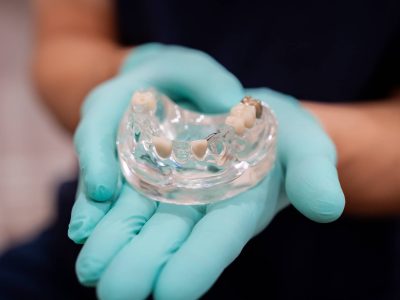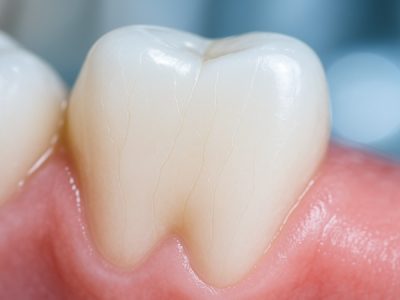Did you know that brushing only cleans 60% of the surfaces on your teeth? This means bacteria and food debris can collect in the crevices of teeth, leading to the development of plaque, tooth decay, and gum disease.
Interdental cleaning, often completed by flossing, is the professional term for cleaning between the teeth and is important for good oral health. If you want to clean your teeth properly, the use of floss or another interdental cleaner is a critical part of a good oral hygiene routine.
In this article, we’ll cover how to clean your teeth properly, including an in-depth look at interdental cleaning and why it is crucial to your oral health.
Why Is Interdental Cleaning Important?
Without proper interdental cleaning, plaque — a sticky build-up of bacteria — can form on teeth and lead to gum disease.
Complications from not flossing include:
- Tartar build-up (hardened plaque that must be removed by a dental professional)
- Cavities
- Gingivitis (early stages of gum disease)
- Gum disease
- Health complications (oral health is closely linked to overall health)
- Bad breath
- Gum recession
- Tooth loss
- Serious infections
What Is the Best Tool for Interdental Cleaning?
While string floss is the most common tool for interdental cleaning, there are various other tools available, including:
- Flossettes
- Interdental brushes
- Water flossers
Flossettes are handy little tools that have a handle and a curved end holding a small piece of dental floss. Flossettes are ideal for:
- Children who are learning how to floss properly
- Parents who are helping their children floss their teeth
- Individuals with decreased fine motor skills
Interdental brushes are another easy alternative to flossing. With an appearance that mimics a miniature bottle brush, these convenient tools are an effective way to clear away bacteria, food debris, and plaque. They come in various sizes, can be reused several times, and are especially helpful for:
- Individuals with braces (interdental brushes can help clean between the teeth, even if you have braces, and can be used to clean the wire and brackets as well)
- People who do not like traditional dental floss
- Individuals with decreased fine motor skills
- Individuals with large gaps in their teeth where the floss is too thin to be effective
Your dental professional can advise you on the correct wire and bristle size for your teeth, as well as how to use the interdental brush properly.
Water flossers use a powerful stream of water to dislodge food debris and plaque from teeth and can be ideal for:
- Individuals with decreased fine motor skills
- Individuals with braces
Interdental Brushes, Flossetes, Water Flossers, or Dental Floss — Which Is Better?
Now that we’ve described the different methods of interdental cleaning, we’ll look at the pros and cons of each to help you choose the best approach.
Interdental Brushes
Pros
- Easier to manage for individuals with decreased dexterity
- Excellent for use with braces
- Effective at removing bacteria and food debris from crevices
Cons
- More expensive than traditional dental floss
Dental Floss
Pros
- A most affordable option for interdental cleaning
- Extremely effective
- Easy to store and travel with (keep a pack in your car, your purse, or at your desk at work so you always have some handy)
Cons
- Great for cleaning tight spaces but not as effective for wide spaces (can also get stuck between the teeth if there is too tight of a space)
- Difficult to use with braces
Water Flossers
Pros
- Are excellent for hard-to-reach areas
- Are helpful when used with braces
- Are gentler on the gums
Cons
- More expensive
- Not as effective at removing plaque as traditional dental floss
- Often recommended to be used as a supplement to regular dental floss, not a replacement
- Can get a bit messy
- Take some learning to get used to (what angle to hold it at, how much water pressure to use)
- Can be helpful for individuals with arthritis or poor fine motor skills
- Harder to transport
- Take up more storage space
Flossettes
Pros
- Are often helpful for children (the handle can be easier for them to maneuver until they learn how to hold traditional dental floss)
- Can be easier to use for individuals with decreased fine motor skills
- Can be helpful for parents who wish to help floss their children’s teeth
Cons
- More expensive than string dental floss
- More wasteful than traditional floss
Ultimately, each of these tools provides an effective way to clean your teeth properly. The most important step is finding a tool for interdental cleaning and using it daily.
If you are struggling to find the right tool for interdental cleaning, please do not hesitate to reach out to us for a recommendation.
Tips for A Good Oral Hygiene Routine
Along with brushing twice a day and flossing at least once a day, here are additional steps in a healthy oral hygiene routine:
- See your dentist for regular checkups (these checkups ensure any oral health problems are caught early before additional complications arise)
- Pay attention to the amount of sugar you consume
- Do not chew on hard or non-food objects such as ice cubes, fingernails, pens, etc.
- Use a mouthwash recommended by your dentist
- Use a toothpaste containing fluoride
- Do not use toothpicks to clean between your teeth (they can splint, cause gum damage, and wear away teeth with regular use)
- Ask your dentist for instructions on proper flossing techniques
FAQs About Flossing
Q: When should children start flossing?
A: Once your child has two teeth that are next to each other, it is time to help your child start flossing. This typically occurs around age 2. Many parents report flossettes being the easiest way to floss a child’s teeth. Establishing healthy oral hygiene habits early on is key for setting your child up for a lifetime of healthy teeth. If you are not sure how to floss your child’s teeth, please contact us for more information.
Once your child improves their fine motor skills, they can take over the task of flossing. However, it is important to monitor your child’s flossing habits to ensure they are doing a thorough job.
Q: Is it normal for my gums to bleed when I floss?
A: No, healthy gums should not bleed. If you are experiencing bleeding when you floss, it almost always indicates that you need to be flossing more frequently. When you skip flossing, plaque can build up and lead to gum inflammation and sensitivity. Sensitive, inflamed gums are more likely to bleed during flossing. Be sure to let your dentist know if you notice bleeding during flossing.
Final Thoughts
Brushing your teeth twice a day is a crucial part of a good oral hygiene routine. However, brushing alone will not clean your teeth properly.
Interdental cleaning is an important step in keeping your teeth and gums as healthy as possible. If you have questions about cleaning your teeth properly, would like instructions on flossing, or would like personalised advice on the right dental tools for you, please feel free to contact us.








